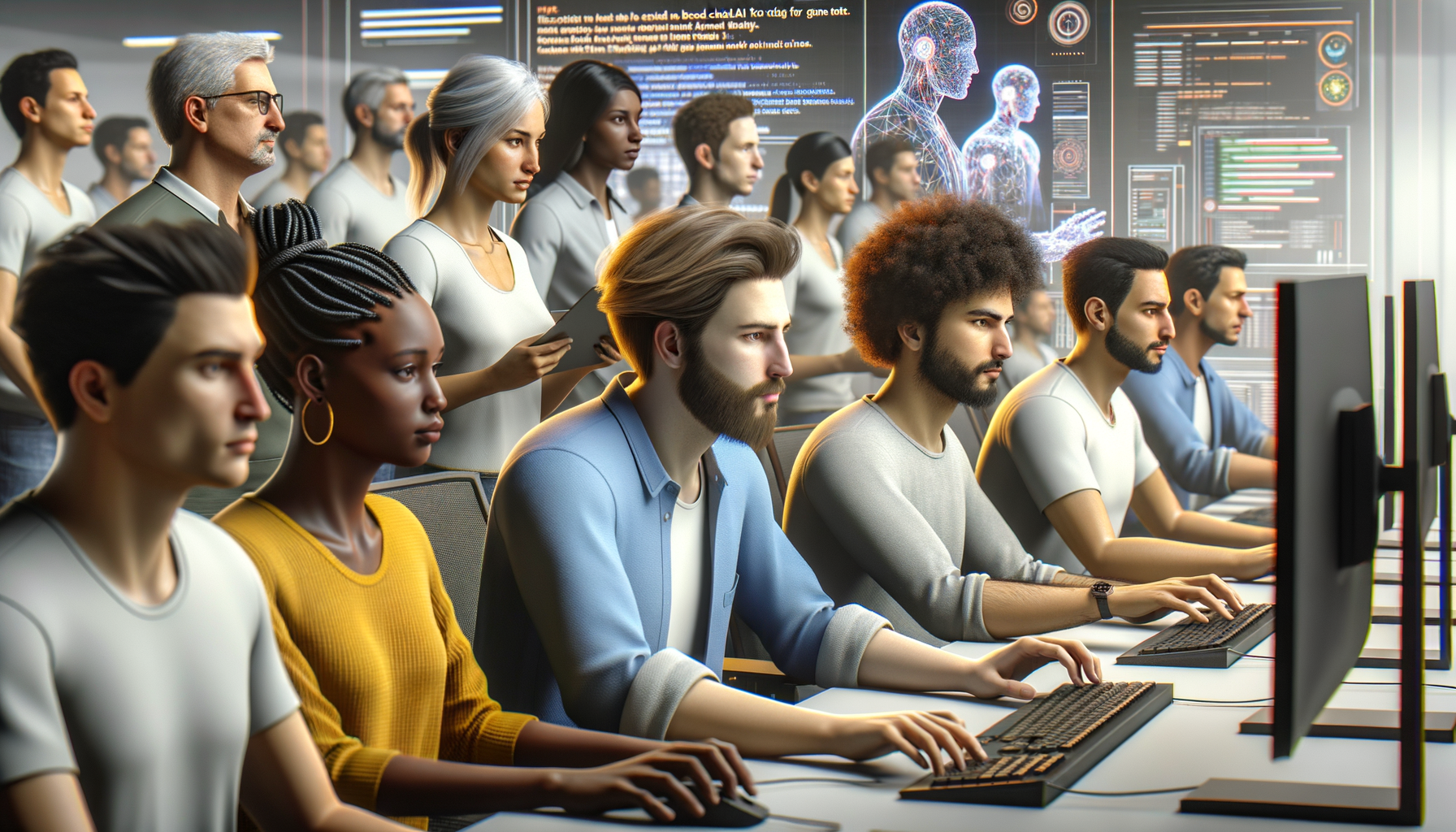Overview of Cloud-Based AI Tools for Game Testing

Key Points
- AI-driven game testing automates repetitive tasks and enhances efficiency.
- Cloud-based tools allow for scalable, flexible testing environments.
- Integration with existing development pipelines is streamlined through APIs.
- Real-time data analytics help in quick identification and resolution of issues.
- Enhanced user experience through continuous feedback and improvement cycles.
What are Cloud-Based AI Tools?
Cloud-based AI tools for game testing leverage artificial intelligence hosted on cloud platforms. They streamline and enhance the testing process of video games. These tools provide game developers with remote access to powerful testing capabilities by harnessing the scalability and accessibility of cloud computing. This reduces hardware dependency and enables continuous integration and delivery within the game development lifecycle.
These AI-powered tools simulate real-user interactions, automating gameplay testing. They ensure a comprehensive examination of the game under various conditions that human testers might not consistently replicate. Additionally, cloud-based solutions effectively handle large volumes of testing data. Developers can utilize this data to refine AI models and continuously enhance testing algorithms.
Benefits of Using AI in Game Testing
Implementing AI in game testing offers significant benefits. Firstly, it reduces testing time by automating repetitive tasks and efficiently analyzing game performance under various scenarios. This accelerates the game’s time-to-market. Secondly, AI can detect complex game behavior patterns that human testers might overlook. This results in a more robust and error-free gaming experience.
Additionally, AI-driven testing continuously improves its strategies based on previous outcomes. It adapts and learns from each test scenario. Cloud-based AI tools provide scalability, allowing developers to scale testing resources based on real-time needs without significant investments in physical infrastructure. This makes it a cost-effective solution.
Challenges in Traditional Game Testing

Limited Scope and Scalability
Traditional game testing methods often struggle with scope and scalability. As games become more complex, they require testing of an increasing number of scenarios. Human testers can only cover so much ground. As the game evolves, keeping up with the testing requirements becomes a daunting task.
This limitation slows down the development process and increases the risk of bugs and issues going unnoticed. This can be detrimental to the game’s success post-launch.
High Costs and Resource Intensity
Manual testing is resource-intensive, requiring significant human labor which can be costly. Additionally, setting up the infrastructure necessary for comprehensive testing can further escalate costs. Traditional game testing is a major financial burden for small to medium-sized game development studios.
Moreover, the inflexibility in resource allocation means that scaling up or down as per project requirements isn’t straightforward, leading to either resource wastage or a shortage, both of which can affect the efficiency of the testing process.
Solving Scalability and Efficiency with AI

Step 1: Implementing AI Test Bots
To address scalability, the first step is implementing AI-driven test bots that can simulate thousands of user interactions with the game. These bots can operate 24/7, testing various aspects of the game across multiple platforms simultaneously, thus expanding the scope of testing far beyond what is possible manually.
These AI bots are designed to learn from each interaction, becoming more efficient over time at identifying potential issues, from minor glitches to critical bugs that could impact the user experience.
Step 2: Integrating Cloud-Based Solutions
The next step involves integrating these AI capabilities with cloud-based platforms. This integration enables the flexible allocation of resources, where testing capabilities can be scaled up or down based on the needs of the development cycle, without the need for heavy upfront investment in physical infrastructure.
Cloud platforms also facilitate the collection and analysis of data from game tests, which developers can use to further refine testing strategies and continuously improve game quality.
Step 3: Continuous Learning and Adaptation
The final step is to set up a system for continuous learning and adaptation. AI tools on cloud platforms can analyze the data collected from various tests to identify patterns and predict potential future issues. This proactive approach not only helps in immediate problem-solving but also aids in the long-term improvement of game design and testing processes.
By continuously learning and adapting, AI-driven testing tools can help ensure that the game remains robust against an ever-evolving landscape of user expectations and technological advancements.
Code Example: Implementing AI Game Testing

Here’s an example of Python code using the Pytest framework to implement an AI-driven game-testing bot that can be integrated into a cloud environment. This bot is designed to automatically test game functionality.
import pytest
import requests
class GameTestBot:
def __init__(self, base_url):
self.base_url = base_url
def test_login(self):
response = requests.post(f"{self.base_url}/login", data={"username": "test_user", "password": "securepassword"})
assert response.status_code == 200
def test_gameplay(self):
response = requests.get(f"{self.base_url}/start_game")
assert response.status_code == 200
game_data = response.json()
assert game_data['status'] == 'started'
def test_score_update(self):
response = requests.patch(f"{self.base_url}/update_score", data={"score": 5000})
assert response.status_code == 200
updated_data = response.json()
assert updated_data['score'] == 5000
@pytest.fixture
def bot():
return GameTestBot("http://example.com/api")
def test_game(bot):
bot.test_login()
bot.test_gameplay()
bot.test_score_update()
This code defines a simple AI game-testing bot that performs basic actions like logging in, starting a game, and updating scores. It uses HTTP requests to interact with the game’s backend API, simulating user actions and verifying the responses. The use of assertions ensures that each test step must pass specific conditions to succeed, providing a robust framework for automated game testing.
Frequently Asked Questions

What are the primary advantages of using cloud-based AI tools for game testing?
Cloud-based AI tools for game testing offer scalability, efficiency, and cost-effectiveness. They allow for extensive automated testing across various platforms and conditions without the need for extensive physical infrastructure. Additionally, these tools can learn and adapt, improving their testing effectiveness over time.
Another significant advantage is the ability to integrate these tools into existing development pipelines seamlessly, allowing for real-time testing and feedback that can drastically reduce development cycles and improve game quality.
How do AI tools simulate user interactions in game testing?
AI tools use machine learning algorithms to simulate a wide range of user behaviors and interactions within the game. These simulations are based on data collected from real user interactions, which helps the AI understand and replicate human behavior in a controlled testing environment.
This capability allows AI tools to perform comprehensive testing that includes edge cases and unlikely scenarios, ensuring the game is robust and performs well under various conditions.
Can cloud-based AI tools replace human testers?
While cloud-based AI tools excel at automating and scaling the testing process, they are not intended to entirely replace human testers. Human insight remains crucial for understanding complex user experiences and making creative decisions during game development.
Instead, developers should use AI tools as a complement to human testers, allowing them to handle the more repetitive and extensive testing tasks while humans focus on areas requiring more nuanced judgment and creativity.
What types of games can benefit most from AI-driven testing?
All types of games, from mobile and indie games to large-scale multiplayer online games, can benefit from AI-driven testing. However, games with complex environments, multiple user pathways, and high user interaction levels see the most significant benefits due to the extensive coverage and efficiency of AI testing.
AI-driven testing is particularly beneficial in the early stages of game development, where it can help identify and resolve potential issues before they become more significant problems.
Are there any limitations to using AI for game testing?
One limitation of using AI for game testing is the initial setup and training phase, which can be resource-intensive. AI models require a substantial amount of data to learn effectively, and setting up an effective testing framework can require significant upfront investment in terms of time and expertise.
Additionally, AI-driven testing may not be able to fully understand or replicate the emotional and subjective experiences of human players, which can be crucial for the game’s success. Therefore, it’s important to maintain a balance between automated and manual testing methods.
Looking Ahead: The Future of AI in Game Testing

As the gaming industry continues to grow and evolve, so too will the technologies used to test and develop games. Here are five predictions for the future of AI in game testing:
- Increased Integration of AI and Machine Learning: AI will become even more integrated into the game development process, providing more advanced tools for automated testing and real-time feedback.
- Enhanced Realism in Game Testing: AI tools will be able to simulate human behavior and decision-making processes with greater accuracy, allowing for more realistic and thorough testing.
- Greater Emphasis on Security Testing: As games become more connected and multiplayer experiences grow, security will become a more significant concern. AI will play a crucial role in continuously testing and securing game environments against potential threats.
- Development of AI as a Service (AIaaS) for Game Testing: Cloud platforms may offer AI testing as a service, providing game developers with flexible, scalable, and cost-effective testing solutions without the need for in-house AI expertise.
- Expansion of AI Beyond Testing: AI’s role in game development will expand beyond testing to include areas like game design, content generation, and player support, creating more dynamic and immersive gaming experiences.
More Information
- Reddit discussion on Google’s patent for automating game testing using AI
- Remote playtesting for mobile games — PlaytestCloud
- Future of Game Testing: Utilizing AI to Enhance Gaming Experience
- Generative AI | Google Cloud
Disclaimer
This article is AI-generated with educational purposes in mind and does not intend to provide specific advice or recommend its implementation. It aims to inspire further research and exploration into the topics covered.
- The Agentic Startup Manifesto - June 8, 2025
- Remote Hiring in 2025 - April 5, 2025
- Burnout in Remote Teams: How It’s Draining Your Profits - January 27, 2025
